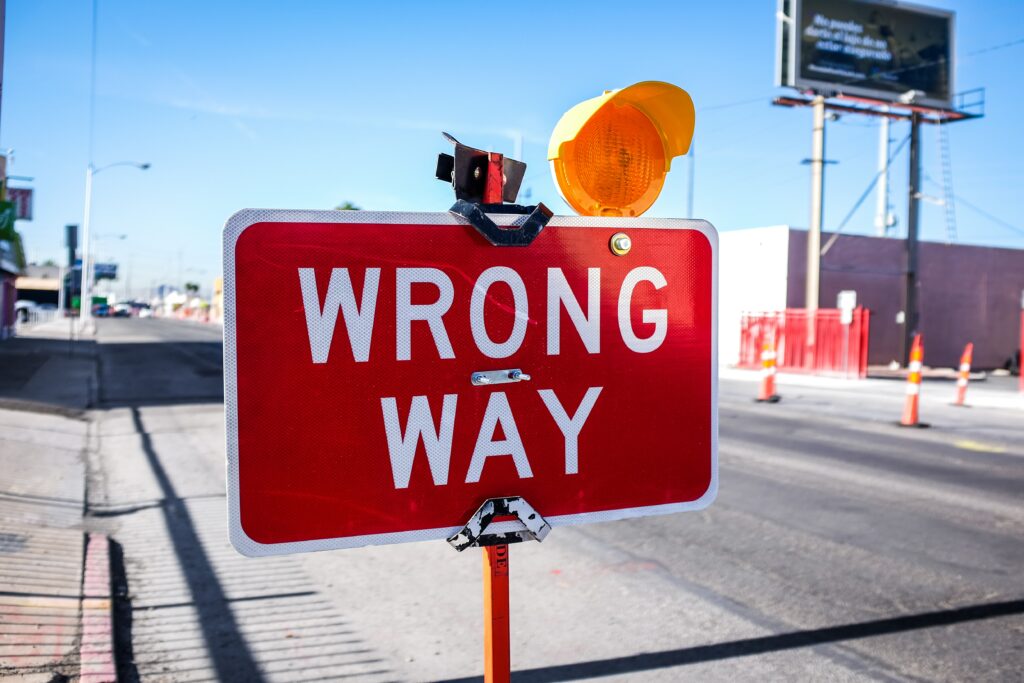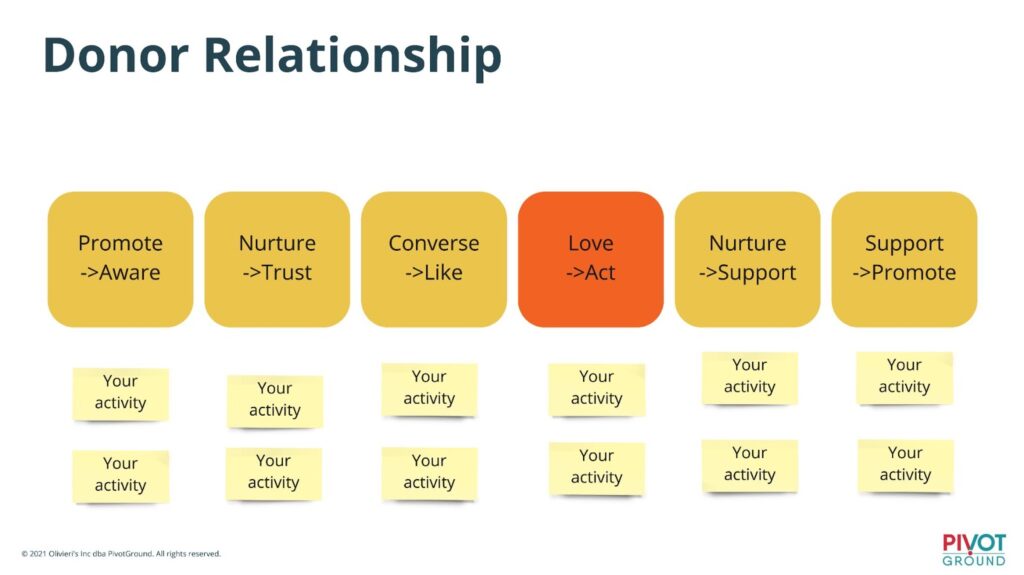Stop Fundraising Without a Strategy: How to Engage Your Donors with Confidence


Fundraising without a strategy can have really devastating results …primarily not having enough money.
Nonprofit leaders often get ahead of themselves, prioritize the wrong things, and end up in a fundraising rut. By that time, not only are they struggling with money even worse than before, but they are also tired and frustrated.
3 Common Fundraising Pitfalls


Maybe you’ve found yourself in one of these ruts. Hopefully, I can warn you before you end up there. Let’s talk about fundraising pitfalls so you can steer clear of them.
1. Grants
Grants can be incredibly helpful for funding nonprofits, but the number one pitfall I hear most often is focusing on grants too soon.
Many nonprofits rely solely on grants for funding, but grants aren’t very sustainable. Nonprofits get very involved in the grant cycle, which takes up a lot of time and energy, and then there are no resources left to build your fundraising strategy.
My advice… make sure you have a solid donor base and build your donor-based fundraising strategy before you think about grants. Donor-based fundraising is scalable, sustainable, and will serve you better long term.
Write the Perfect Grant Proposal
Writing Grant proposals shouldn’t be so stressful. Use this toolkit to organize your application and write a compelling proposal.
2. New Donors
Nonprofits are always going after new donors and not nurturing their existing ones. I hear this all the time from fundraising professionals!
New donors require much more time and effort to get them to a place where they are willing to make a donation. Your existing donors are already primed to give, as you have already had success with them in the past.
Don’t forget about your existing donors by focusing too much on new ones. In fact, who your actual donors are may surprise you. Check out this training to learn how well you know them.
3. Current Crisis or Trends
The third fundraising pitfall I see is nonprofit organizations reacting to the latest trends or current crises. I encounter so many nonprofits in a panic saying “Oh my God, we need another $40,000 now!”
These nonprofits can be described as reactive and what we want are proactive nonprofits. This can be solved with…you guessed it, a fundraising strategy.
4 Tips for Building Your Nonprofit’s Fundraising Strategy
So what might that strategy look like? There are lots of amazing methods out there, but let’s build one out together.
1. Stay Organized
I am a strategy expert and I have to tell you something I’ve learned about strategies over the years… they are not all created equal.
In fact, the way you organize your strategy can dramatically impact how good it is in the end.
Here are some ways that you might organize your fundraising strategy.
- Calendar – organizing your strategy based on the time of year.
- Monetary goals – organizing your efforts based on when you need the money.
- Donor segment – organizing your strategy around small, medium, and large donors.
- Activity type – events, gala, race, etc. Organizing your efforts around your fundraising activities.
- Campaigns – using a theme to raise money, i.e. Giving Tuesday
- Donor relationship – organizing your strategy around the stages of the donor relationship journey.
Do you notice anything about these 6 methods?
All of them except one are centered around you. Only the donor relationship concept as an organizing principle is about them.
That is way too many you’s! And at the end of the day, what is fundraising all about? What is the end goal? It’s about getting them to give you their money.
If you want your fundraising strategy to be the most successful, you are going to organize it around your donors’ experience, not your experience.
2. Consider the Donor Relationship Journey
When creating your fundraising strategy, the next thing you have to think about is where the donor is on the journey. A typical donor relationship journey has these 6 stages.
- Aware – They know you exist. You went from completely non-existent to existent.
- Trust – They recognize you’re not a scammer. They’re willing to listen to you. They’re starting to have some trust in you.
- Like – They’re ready to consider liking you. Are you their style? Are you doing something that they care about enough that they want to give you their money?
- Action – They like you enough to take action. The more they like you, they’ll level up their action. They’re testing the waters with that first gift.
- Support – If they’ve had a good experience, they will come to support you. This means they will give over and over again. They become people you can call when you need money.
- Promote – Your most devoted supporters will become promoters. These are your raving fans. They will make new donors aware of you and get all of their friends on board. They’re the ones who are going to organize events for you and do all of their birthday fundraisers for your organization.
For more on building out the donor journey portion of your strategy, check out this article.
After identifying where your donor is in their journey, you’ll want to organize your activities.


Build Your Nonprofit’s Donor Stewardship Plan
Stewardship activities are touchpoints for nurturing your donor relationships and helping to increase your donor retention rate. With this FREE template, you can map out your donor stewardship plan.
3. Map Out Your Activities


This is where you really start to build out your strategy and it can be a bit overwhelming. Break it down by determining what each activity aims to accomplish.
Does this activity make donors aware that you exist? Does this activity make donors like you?
Once you start placing your activities in these columns, you may notice that you have some columns that are full and some that are rather sparse.
This is a good indicator of where you need to work on your activities.
Skipping steps doesn’t work in a donor relationship. You don’t meet a stranger on the corner and then ask them to fall in love with you and get married immediately, right? No! They’re going to tell you to back off. That’s too much too soon.
Make sure you have enough activities present in each column to support your donors at every step of their journey.
4. The Organization Journey


One trick about fundraising is that most strategies are actually two strategies in one. In the image above, I take organizing my activities one step further by using the organization journey. Your journey may look something like this.
- TBD – things you’re planning to do, but haven’t started yet.
- In development – activities that you’re currently working on or testing out.
- Active – activities that are already in place and part of your routine.
- RIP – I like to track all of the things that didn’t work so when new people come in and suggest something you’ve already tried, you have the receipts.
Use this grid to categorize all of your efforts and you’re well on your way to having an amazing fundraising strategy.
How Nonprofits Can Share Transformation Stories Strategy
The last thing I want to talk about are stories. Stories are one of the best ways to communicate with other human beings.
Transformation stories as an activity fit in many columns on the donor relationship journey, but especially in the “like” column. If you want them to like you, you should tell them an amazing story of transformation. For example, how you helped transform someone who was suffering into someone who was joyful.
Transformation stories are also really powerful in the support column. They are helpful for getting existing donors to level up their support and for convincing new donors to give for the first time.
The trick is to not make it about you. It’s about someone you helped. The people you help are the heroes and you and your donors are the conduits for helping them succeed on their journey. You and your donors are Yoda and the people that you help are Luke Skywalker.


Communicate Your Impact with this FREE Storytelling Toolkit
Use this toolkit to discover the key elements of a good impact story and learn how to write and get access to a template so you can get a head start on your writing.
Final Thoughts
This is a basic understanding of what a donor-centric fundraising strategy can look like. This method shows you how to deal with your priorities while also understanding where your donors are on their journey. Organizing your strategy around the donor experience is the number one best way to avoid those nasty fundraising pitfalls.
If you’d like to dig deeper, check out my Leveraged Donor Strategy Masterclass. In this course, I walk you through how to create and implement a donor strategy framework that will change the way your organization fundraises.
If you still find your organization struggling with fundraising, I am here to help. Book a free consultation with me. I’d love to connect with you and learn about your organization.
You can also check out my YouTube channel for additional resources on everything from fundraising to DEI to strategy.
See How Nonprofits Use Keela to Raise 4x More!
Get a glimpse of how Keela’s donor management system can help you develop better relationships, retain donors and raise more for your cause.


About the author:
Sarah Olivieri, MPS
Founder, PivotGround
Sarah Olivieri is a nonprofit business strategist, #1 International Best Selling Author, and former Executive Director. She has been featured on over 30 podcasts and is the creator of the Impact Method™ – a framework that helps nonprofits simplify their operations, build aligned teams, and make a bigger impact without getting overwhelmed or burning out. As the founder and heart behind PivotGround, Sarah helps nonprofits make a big impact with relative ease.





